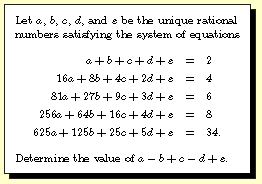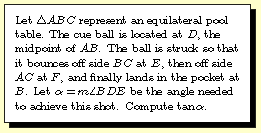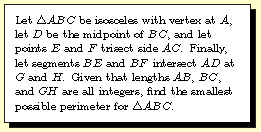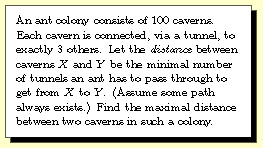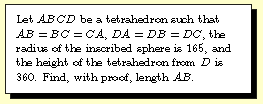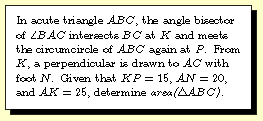... .....
|
Past Corner Problems: 2001 |
|
......
![]()
|
The Problems: |
The Solvers: |
|
Question 2001-1 |
...... |
|
Question 2001-2 |
......
|
|
Question 2001-3 |
...... |
|
Question 2001-4 |
......
|
|
Question 2001-5 |
...... |
|
Question 2001-6 |
......
|
|
Question 2001-7 |
...... |
|
Question 2001-8 |
......
|
|
Question 2001-9 |
...... |
ANSWERS TO 2001
PROBLEMS
Question 2001-1
-- Use the law of sines to determine that cos2C =
7/8, work from there with law of cosines to obtain
BC2=126.
Question 2001-2 -- Let
f(x)=ax4+bx3+cx2+dx+e,
and argue that we must have
f(x)=(x-1)(x-2)(x-3)(x-4)+2x.
Therefore f(-1)=118, the desired quantity.
Question 2001-3 -- By
reflecting the figure over successive sides to straighten
the path, we find tan(a)=2Sqrt[3]
and total path length is Sqrt[13].
Question 2001-4 -- Using
a 15-20-25 right triangle we can make the perimeter as small
as 80.
Question 2001-5 -- One
can prove that the largest distance is no more than 72. Can
you find a configuration of tunnels and caverns that attains
this maximum?
Question 2001-6 --
Routine solid geometry formulas along with the Pythagorean
theorem produce AB=1980.
Question 2001-7 -- This
one was tricky. Argue that area(ABC)=15(AB+AC)/2,
then use Ptolemy on ABPC and show that BP=PC=5(BC)/8. This
leads to area(ABC)=480.
Question 2001-8 -- One
possible approach is to replace cos2x by
(1+cos(2x))/2, and similarly for the other terms,
then use a summation formula to reduce the equation to (sin
4x)(cos 5x) / (sin x) = 0, yielding the
solutions x=18, 45, 54, or 90 degrees.
Question 2001-9 --
Substitute X=(sin a)(sin b), Y=(sin a)(cos b), and Z=cos b
to reduce to (X+Y-2Z)2>=0.
......


